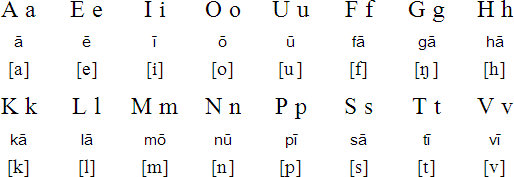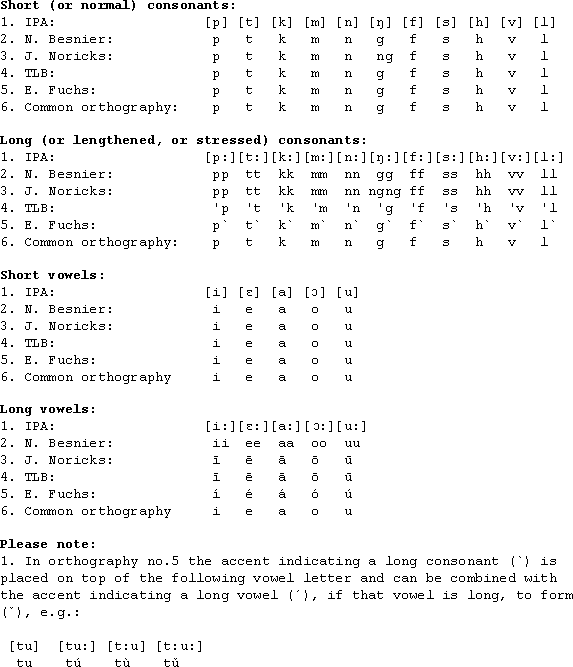Tuvaluan is a Polynesian language spoken in Tuvalu in the south-central Pacific, and by small groups of Tuvaluan migrants in Australia, Fiji, Kiribati, the Marshall Islands, Nauru, New Zealand and the USA. In 2015 there were about 10,000 speakers of Tuvaluan in Tuvalu, and there are about 2,000 Tuvaluan speakers in other countries.
On one of the Tuvaluan islands, Nui, a Micronesian dialect of Kiribati is spoken. However, most Nui islanders are now bilingual in their vernacular and in Tuvaluan.
Within the Polynesian family of languages Tuvaluan belongs to the so-called Samoic-Outlier group, and is most closely related to the languages of Tokelau, Futuna and Samoa, but also - though more distantly - to Tongan, Tahitian, Hawaiian and Maori.
Each island has its own dialect but all Tuvaluan dialects are mutually intelligible. There are two dialect areas: Northern (consisting of the islands of Nanumea, Nanumaga, Niutao and Niulakita), and Southern (the islands of Vaitupu, Nukufetau, Funafuti and Nukulaelae). For historical reasons, the dialects of Vaitupu and Funafuti have been dominant since the first half of the 20th century. They now constitute together a kind of standard language which is called te 'gana māsani ("the common language").
Tuvaluan first appeared in writing during the 1860s when Samoan pastors of the London Missionary Society began to convert the islanders to Christianity. However no standard orthography exists as yet, and several systems (designed by linguists or missionaries) are in use (see below). System no. 4 is the one recommended by the now defunct Tuvalu Language Board (TLB), but most Tuvaluans use the one called here "common" (no. 6) in which no distinction is made between short and long phonemes.
The vowel inventory of Tuvaluan consists of the five "cardinal" vowels, and is similar to most other Polynesian languages in that respect. All vowels can be short or long (short vowels have approximately Spanish values).
The consonant inventory comprises of eleven consonants as listed below. Some Northern dialects have [h] where the Southern dialects have [s]. For example: the word for "one" is tahi in Nanumea and Nanumaga, and tasi in the South. Unlike all the other languages inside the Polynesian triangle (Hawaii - New Zealand - Easter Island), the Southern dialects and Nanumea have both short and long (or lengthened) consonants. They share this feature with some of the Polynesian Outlier languages in Melanesia. Lengthened consonants are in most cases the result of reduplicated syllables with subsequent loss of the unstressed vowel between the two identical consonants, e.g.: 'pono < popono ("to close").
The Tuvaluan syllable structure may be summarised as follows: (C(:))V(:), i.e.: an optional consonant which could be short or long, followed by an obligatory short or long vowel.
Stress is always on the penultimate syllable, except when the last vowel is long, in which case the last syllable is stressed.
Full and partial reduplication as well as prefixes and suffixes are used extensively for word formation and the expression of various grammatical and semantic categories (intensive, diminuitive, causative, passive, nominalisation etc.)
Very often the word order is subject - verb - object, but this is not necessarily so and ergative constructions are quite common in Tuvaluan, e.g.: ne fai te gāluega nē ia, "he did the job" - lit. "past tense particle - do - the - job - ergative particle - he/she".
The Tuvaluan lexicon is not yet well adapted to present-day needs and will have to be actively developed further if "Pidginisation" of the language by freely borrowing from English is to be avoided. Apart from English loans, Tuvaluan - due to the influence of the missionaries - also contains a large number of words borrowed from Samoan.
There is still not much printed literature available in Tuvaluan but a revised translation of the Bible has been completed recently (the original translation dates from 1977/1984), and a Tuvaluan hymnbook is in use by the state church EKT (Ekalesia Kelisiano Tuvalu). This church also publishes a monthly bilingual bulletin. Jehovah's Witnesses issue an excellent translation of their magazine "The Watchtower" as Te Faleleoleo Maluga twice a month. The governmental media department on Funafuti publishes a monthly bilingual newspaper called "Sikuleo o Tuvalu - Tuvalu Echo" (previously: Tuvalu Echoes), and the department's Radio Tuvalu broadcasts several hours a day in English and Tuvaluan.

Download an alphabet chart for Tuvaluan (Excel)

Tēfea toku vaka?
Where is my canoe?
Kāfai e tō te vaiua kā 'siu tātou.
If it rains we shall get wet.
E isi se mea e manako koe ki ei?
Is there something you want?
Koe e fano ki fea?
Where are you going?
E sēai se vakalele mātaeao.
There is no airplane tomorrow.
Ne faka'tū nē lātou olotou fale i te taisala.
They errected their houses in the swamp.
E 'lei mea katoa!
Everything is all right!
E fā'nau mai a tino katoa i te saolotoga kae e 'pau telotou tūlaga fakaaloalogina mo telotou aiā. Ne tuku atu ki a lātou a te mafaufau mo te loto lagona, tēlā lā, e 'tau o gā'lue fakatasi lātou e pēlā me ne taina.
A recording of this text by Tauina Lesaa, provided by Moshe Ash.
All human beings are born free and equal in dignity and rights. They are endowed with
reason and conscience and should act towards one another in a spirit of brotherhood.
(Article 1 of the Universal Declaration of Human Rights)
The information on this page comes from Emanuel Fuchs, a linguist from Vienna, Austria.
Information about Tuvaluan | Phrases | Numbers | Family words | Tower of Babel
Information about Tuvaluan language
http://www.tuvaluislands.com/lang-tv.htm
http://en.wikipedia.org/wiki/Tuvaluan_language
http://www.scribd.com/doc/2993349/tuvalu-language
Country profile: Tuvalu
http://news.bbc.co.uk/1/hi/world/asia-pacific/country_profiles/1249549.stm
Languages written with the Latin alphabet
Page last modified: 23.04.21
[top]
You can support this site by Buying Me A Coffee, and if you like what you see on this page, you can use the buttons below to share it with people you know.

If you like this site and find it useful, you can support it by making a donation via PayPal or Patreon, or by contributing in other ways. Omniglot is how I make my living.
Note: all links on this site to Amazon.com, Amazon.co.uk
and Amazon.fr
are affiliate links. This means I earn a commission if you click on any of them and buy something. So by clicking on these links you can help to support this site.
[top]